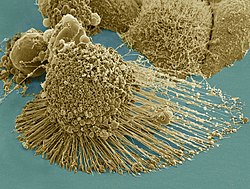Immortalised cell line
| Immortalised cell line | |
|---|---|

Scanning electron micrograph of an apoptotic HeLa cell. Zeiss Merlin HR-SEM.
|
|

HeLa cells, an example of an immortalised cell line. DIC image, DNA stained with Hoechst 33258.
|
|
|
Anatomical terminology
[]
|
An immortalised cell line is a population of cells from a multicellular organism which would normally not proliferate indefinitely but, due to mutation, have evaded normal cellular senescence and instead can keep undergoing division. The cells can therefore be grown for prolonged periods in vitro. The mutations required for immortality can occur naturally or be intentionally induced for experimental purposes. Immortal cell lines are a very important tool for research into the biochemistry and cell biology of multicellular organisms. Immortalised cell lines have also found uses in biotechnology.
An immortalised cell line should not be confused with stem cells, which can also divide indefinitely, but form a normal part of the development of a multicellular organism.
There are various immortal cell lines. Some of them are normal cell lines - e.g. derived from stem cells. Other immortalised cell lines are the in vitro equivalent of cancerous cells. Cancer occurs when a somatic cell which normally cannot divide undergoes mutations which cause de-regulation of the normal cell cycle controls leading to uncontrolled proliferation. Immortalised cell lines have undergone similar mutations allowing a cell type which would normally not be able to divide to be proliferated in vitro. The origins of some immortal cell lines, for example HeLa human cells, are from naturally occurring cancers.
Immortalised cell lines are widely used as a simple model for more complex biological systems, for example for the analysis of the biochemistry and cell biology of mammalian (including human) cells. The main advantage of using an immortal cell line for research is its immortality; the cells can be grown indefinitely in culture. This simplifies analysis of the biology of cells which may otherwise have a limited lifetime.
...
Wikipedia
